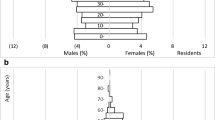Abstract
In an integrated economy the movement of workers among regions is a natural part of the process of economic progress and industrial change. Migration is typically viewed by economists as a labor market adjustment mechanism in that labor migrates from areas of lower to areas of higher economic opportunity.
Migration of the poor has become a matter of increasing public policy concern in recent years, particularly in urban states that have experienced large inflows of low-income migrants. In this study regression analysis is used to identify some of the key factors affecting the migration of the poor into and among large metropolitan areas of the United States between 1965 and 1970. The results support the hypothesis that the poor migrate to areas offering higher welfare benefits. The results also suggest that the poor migrate towards areas which offer more employment opportunities.
Similar content being viewed by others
References
Blanco, Cicely. “The Determinants of Interstate Population Movements.”Journal of Regional Science, V (Summer, 1963), 77–84.
—. “Prospective Unemployment and Interstate Population Movements.”Review of Economics and Statistics, XLVI (May, 1964), 221–22.
Brown, Murray, and Arora, Swarnjit S. “A Utility Maximization Approach to Multipolar Migration Under Uncertainty.” Discussion Paper No. 209, Economic Research Group, Department of Economics, State University of New York at Buffalo, November, 1971. (Mimeographed)
Cebula, R. J.,et al. “Some Determinants of Interstate Migration of Blacks, 1965–1970.”Western Economic Journal, X No. 4 (December, 1973), 500–505.
DeJong, Gordon F., and Donnelly, William L. “Public Welfare and Migration. ”Social Science Quarterly (September, 1973), 329–334.
Gallaway, L. E.,Interindustry Labor Mobility in the U.S. U.S. Department of Health, Education, and Welfare, Social Security Administration Research Report No. 18. Washington, D.C.: Government Printing Office, 1967.
Gallaway, L. E.,et al. “The Economics of Labor Mobility: An Empirical Analysis.”Western Economic Journal, V (June, 1967) 211–223.
Gatons, Paul K. and Cebula, Richard J. “Wage-Rate Analysis: Differentials and Indeterminance.”Industrial and Labor Relations Review, XXV (January, 1972), 207–212.
Glantz, Frederic B. “The Determinants of the Interregional Migration of Economically Disadvantaged,” Unpublished Ph.D. dissertation, Syracuse University, 1972.
Greenwood, Michael J. “An Analysis of the Determinants of Geographic Labor Mobility in the United States.”Review of Economics and Statistics, LI (May, 1969), 189–94.
—. “Lagged Response in the Decision to Migrate.”Journal of Regional Science, X (December, 1970), 375–84.
Johnston, J.Econometric Methods. New York: McGraw-Hill, 1963.
Kain, John F., and Persky, Joseph.The North's Stake in Southern Rural Poverty. Discussion Paper No. 18, Harvard University Program on Regional and Urban Economics. Cambridge: Harvard University, 1967.
Lowry, Ira S.Migration and Metropolitan Growth: Two Analytical Models. San Francisco: Chandler Publishing Company, 1966.
Lurie, Melvin, and Rayack, Elton. “Racial Differences in Migration and Job Search: A Case Study.”Southern Economic Journal XXXIII (July, 1966), 81–95.
Mazek, Warren F.,The Efficacy of Labor Migration With Special Emphasis on Depressed Areas. Working Paper CWR2, Washington University Institute for Urban and Regional Studies. St. Louis: Washington University, 1966.
—. “Unemployment and the Efficacy of Migration: The Case of Laborers.”Journal of Regional Science, IX (April, 1969), 101–7.
Muth, R. F. “Migration: Chicken or Egg.”Southern Economic Journal, XXXVII (January, 1971), 295–306.
Olvey, Lee Donne.Regional Growth and Inter—Regional Migration-Their Pattern of Inter-Action. Cambridge: Harvard University, 1970.
Pack, Janet R. “Determinants of Migration to Central Cities.”Journal of Regional Science, XIII (August, 1973), 249–260.
Schiller, Bradley R. “Empirical Studies of Welfare Dependency: A Survey.”Journal of Human Resources, VIII(Supplement, 1973), 19–32.
Sommers, Paul M. and Suits, Daniel B. “Analysis of Net Interstate Migration. ”Southern Economic Journal, XXXX (October, 1973), 193–201.
Todaro, M. P. “A Model of Labor Migration and Urban Unemployment in Less Developed Countries.”American Economic Review, LIX (March, 1969), 138–148.
Vedder, Richard K. and Cooper, David. “Nineteenth Century English and Welsh Geographic Labor Mobility: Some Further Evidence.”The Annals of Regional Science, VIII, No. 2 (June, 1974), 131–139.
Author information
Authors and Affiliations
Additional information
The analysis and conclusions of this paper represent the views of the author and should not be interpreted as reflecting the views of the Federal Reserve Bank of Boston or the Board of Governors of the Federal Reserve System or its staff.
Rights and permissions
About this article
Cite this article
Glantz, F.B. The determinants of the intermetropolitan migration of the poor. Ann Reg Sci 9, 25–39 (1975). https://doi.org/10.1007/BF01287422
Issue Date:
DOI: https://doi.org/10.1007/BF01287422




